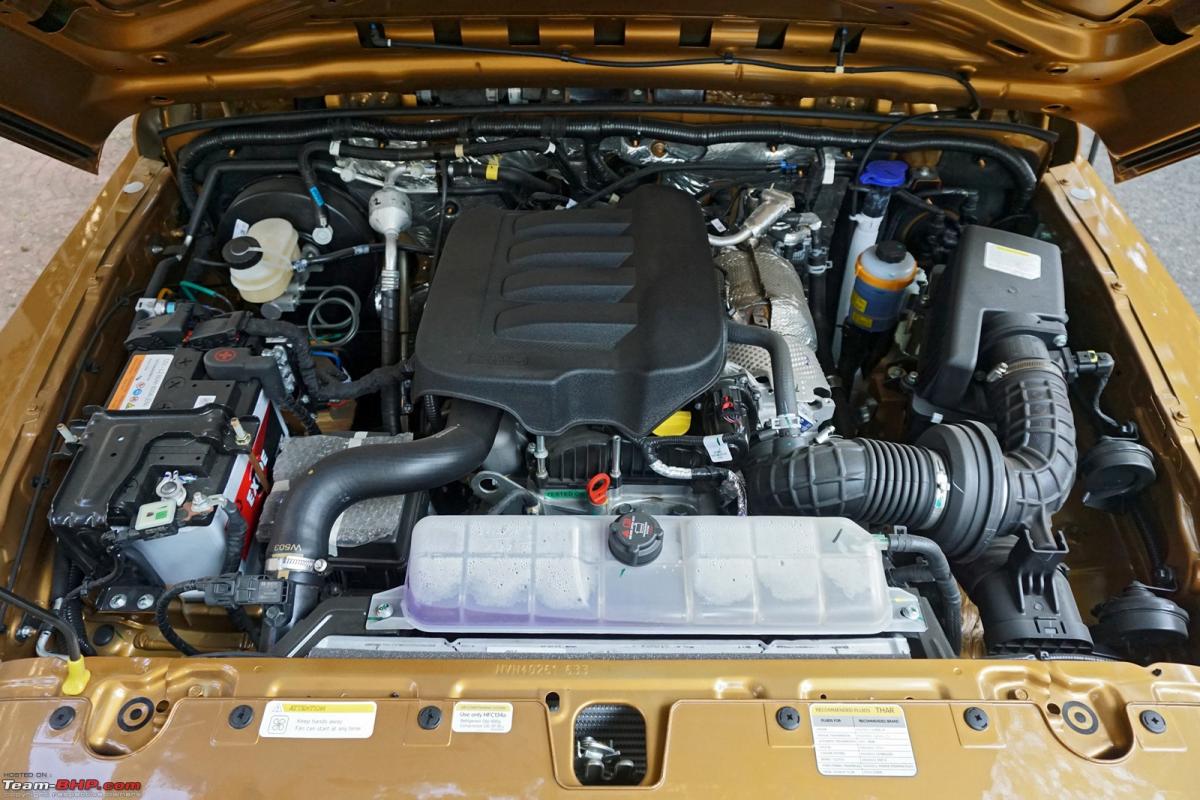News
Mahindra Thar 1.5L RWD : Observations after 5 days of driving
On the open road, the Thar's performance feels strong & there is ample grunt available. Work the engine hard and you can make brisk progress.
Driving the Thar 1.5L Diesel MT RWD
1.5L CRDe engine is carried over from the XUV300 and Marazzo. It puts out 117 BHP & 300 Nm:

The Thar RWD's 1.5L, 4-cylinder, D117 CRDe diesel engine has a variable geometry turbocharger. This engine is only offered with a 6-speed manual gearbox. The engine is shared with the XUV300 and was also plonked in the Marazzo. However, in the Thar, the state of tune is different. Here, it develops 117 BHP (@ 3,500 rpm) against the 115 BHP (@ 3,750 rpm) of the XUV300 and 121 BHP (@ 3,500 rpm) of the Marazzo. Its 300 Nm of torque is identical to its siblings. It is produced at 1,750 - 2,500 rpm, which is identical to the Marazzo, but slightly different from the XUV300 (1,500 - 2,500 rpm). What's interesting to note is that the 1.5L diesel develops only 13 BHP lesser than the 2.2L diesel of the 4x4 and the amount of torque produced is the same!
Unlike the four-wheel drive petrol and diesel variant, this RWD diesel does not have an automatic variant at the moment, which is a big miss in a market that's shifting towards ATs.
Let me start off by saying that this 1.5L diesel is not bad at all. In fact, it’s quite competent and those of you who are going to use it only in the city will have no complaints. To start the Thar’s 1.5L diesel engine, engage the neutral gear and crank the engine. The clutch is quite light, which owners will appreciate. However, it has an annoyingly long travel range - a real bummer in traffic. The gear shifter is light, but again, it has long throws for a car of this class and has a notchy feel to it. Release the clutch gradually and the car moves forward without any throttle input. In fact, with mild accelerator inputs and clutch assistance, you can even move off from a standstill in 2nd and 3rd gears without much effort!
Throttle response is good and the power delivery is acceptable. While there is a hint of lag at the absolute bottom end, driveability is very satisfactory and the smaller 1.5L motor moves the Thar’s bulk quite well in the city. It pulls well once the revvs cross ~1,750 rpm and when the turbo spools at 2,300 rpm, you'll experience a surge of power. This smaller 1.5 does not feel underpowered in the city at all. Keeping up with the traffic is easy. You can potter around in town doing 40 km/h in 4th gear with the tachometer reading ~ 1,300 rpm. The engine feels quite comfortable at this rpm. Even closing gaps to the vehicles in front doesn't require frequent downshifting. The engine can pull from as low as 800 rpm even in 3rd gear.
While the Thar has a tall seating position and good frontal visibility, it has some drawbacks that don't allow it to be an ideal city car. These include the long-throw gear lever, long travel clutch pedal, and not-so-good all-round visibility.
On the open road, the Thar's performance feels strong & there is ample grunt available. Work the engine hard and you can make brisk progress. The mid-range is where the 1.5L diesel is at its best. It feels strong in the 2,000 - 4,000 rpm range. When pushed, the engine will revv to 4,500 rpm. However, there is no point in taking it beyond 4,100 rpm as the power delivery tapers off. The top-end isn't strong, with the engine getting noisy above 3,500 rpm too. In terms of cruiseability, the Thar will do 100 km/h in 6th gear at ~2,450 rpm. Honestly, it's pointless taking the car to higher speeds due to the bouncy ride and mediocre driving dynamics. It's best while cruising at 80 km/h in 6th gear with the engine spinning at ~2,000 rpm.
The car is equipped with an idling start/stop system, which switches off the engine when it's idling to save fuel. However, this can be tricky in stop & go traffic. The car was caught on the wrong foot a few times & we had to restart it manually! While FE-conscious users will keep the feature engaged, most people will switch it off. We found it terribly annoying.
Noise, Vibration & Harshness (NVH)
The 1.5L diesel offers good levels of refinement. Even at high revs, it is refined like you don't expect a Mahindra UV to be. The diesel fires up with very little noise, and without transmitting any noticeable vibrations to the cabin. For a body-on-frame vehicle, there is negligible body shake on start-up and shutdown. In terms of refinement, the motor is not bad at all at idle. While the engine is always audible inside the cabin, it sounds refined and not tiresome. Above 3,500 rpm, the engine gets loud, but it's nowhere as bad as the Mahindra diesels of yesteryears.
Exterior sounds are controlled well in the hard-top. And yes, we mention that the horn is too loud inside the cabin. In the hard-top, wind & road noise get excessive above 100 km/h. These excessive noises can get tiring on long journeys.
Mileage & Fuel Economy
Mahindra has not shared the ARAI rating of the 1.5L diesel MT. However, we expect it to be better than the 4X4 diesel MT, which has an ARAI rating of (15.2 km/l).
Suspension
Ride Comfort
The Thar comes with an independent double wishbone suspension at the front and a multilink suspension with coil-over dampers and a stabiliser bar at the rear. This is a body-on-frame offroader with a short wheelbase. You know what's coming, right? Ride quality is sad, whether in the city or on the highway. It is liveable though. If you have driven Jeeps, Gypsys, Scorpios, or even the 1st-gen Fortuner before, you should be okay. For those used to contemporary hatchbacks, sedans & crossovers, this bumpy ride will be the biggest deal breaker. You feel each & everything on the road – literally! Even on a clean expressway, the Thar is continuously pitching and moving up & down. Big bumps come in strong. And if you drive slowly on broken roads, you can expect a lot of side-to-side swaying. The single time that the Thar is settled & flat is when it’s standing in one place.
It’s not just the suspension, but you feel the unevenness of the road through the steering also. The steering is constantly moving & shaking on bad roads. This excessive feedback will turn off many.
It must be noted that the LX variant we tested was equipped with 255/65 R18 tyres. Lower variants with their 245/75 R16 section rubber should be a little softer.
Handling & Dynamics
The Thar is awesome to drive in the city. It's so easy & effortless that the fairer sex will take to it as well. On the highway though, the Thar's behaviour is poor. For the sake of your safety – and that of your passengers – this is not a vehicle that you drive hard at speed. The Thar is a tall offroader, NOT a corner-carving machine. While I found the grip levels from the fat 255 mm tyres to be satisfactory, you must take corners cautiously. The height & weight are felt. Just to put things in perspective, a fast sweeping expressway curve that I would take in the Duster AWD at 120 km/h, I’ll take in the Thar at 80 km/h as an expert driver (70 km/h for a layman driver).
At 120 km/h, the driver & Thar are both “too busy”. Also, any sudden road dips taken at high speeds badly affect the Thar’s composure. Remember, you are driving a vehicle that is an offroader, as much as an on-roader. Don’t push the limits or go near them. After testing its behaviour at various speeds, I’ll recommend a maximum cruising speed of 110 km/h on expressways and 90 – 100 km/h on old-school 2-lane highways. The shorter wheelbase is responsible for the poor high-speed manners too. Stick to the middle lane of the expressway, cruise at 100 km/h, and enjoy the view. You'll be comfortable & safe this way. Don’t get us wrong, the Thar can do speeds higher than this. However, it won’t be able to handle an emergency manoeuvre or big road dip above 120 km/h. Happy to see ESP being provided for additional assistance if & when required : thumbs up.
This is not a vehicle we would do a Mumbai - Goa run in; the steering is constantly giving feedback, the suspension is busy, there is a lot of wind noise, etc. The Thar can get tiring on those super long journeys. We’d be alright with a 5-hour Mumbai – Mahabaleshwar drive, but that's our upper limit.
Steering
The Thar's hydraulic power steering is user-friendly. While not one-finger light like some EPS units, we have no complaints. It is nice in the city with a decent amount of weight to it. On the highway, at times, its reaction time can be slow, but we actually prefer it this way in a Jeep that is a poor handler (sharp steerings are best suited to low-slung, tight-handling cars). At high speeds, the steering does get vague. But again, we’d rather have vague than sensitive in a tall 4x4.
Braking
All variants of the Thar come with 303 mm disc brakes at the front and 282 mm drums at the rear. ABS + EBD and Brake Assist are standard. The stopping power is adequate, even for those highway runs. That said, the brake pedal sure feels spongy and like most body-on-frame UVs, the Thar nosedives under braking.
Offroading
Coming to offroading, obviously, the Thar RWD will not be as capable as the 4X4. Still, with a ground clearance of 226 mm, chunky all-terrain tyres, and an electronic brake locking differential, this car will still outperform most crossovers on the rough stuff.
Continue reading the discussion on the Mahindra Thar 1.5L RWD on our forum.



















